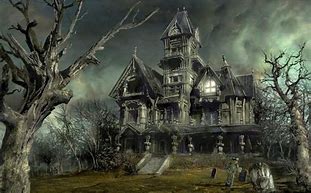| Writing Non-Fiction posted April 17, 2022 |
      |
Atmosphere & Setting
Show, Don't Tell - part III
by giraffmang

In this instalment, we'll look at the importance of 'Show, Don't Tell' in regard to atmosphere and setting.
Anyone who reads my work will know that I like to write a lot of science-fiction, fantasy, and horror stories. One of the major keys to writing a successful tale in these areas is world-building. World-building can be big or small. It doesn’t just apply to a whole planet. It can be a desolate planet, the intricate detail of a wizard’s tower, or a spooky, run-down house, or anything else the writer can imagine. To bring these to life, the writer needs to spend a lot of time envisioning and describing different settings.
But creating a convincing and compelling location is not just the purview of these genres. No matter what kind of setting your story takes place in, you should strive to capture it with a nuance that brings it alive in the minds of your readers.
It’s crucial when developing atmosphere and setting to bring in sensory details to get a real feel for the place. It’s also relatively easy. Wind can bite a character’s cheek, or knuckles can be stiff as they unwrap ice-encrusted hands from snow-shovels.
When creating your setting go deeper than just telling the reader ‘It was dark.’ Think about how that darkness impacts the character – what can they see, feels, sense. Think about how you would feel. (Avoid naming the sense though.)
Using character is a wonderful way to create atmosphere. It also gives movement to a piece, having the character in motion through the setting as the details are revealed rather than just stating it. The character’s feelings can help to colour the setting and atmosphere.
This example is from April Daniels’ ‘Dreadnought’.
‘Mom takes me to the discount shoe store downtown, one of those places with the neon-orange carpet and the salespeople who are a little too friendly to feel safe around. The door gives an electric chime as we enter the shop, which summons them like sharks to bloody water.’
Notice that there is nothing inherently threatening about the shop itself but the point of view character makes it so and paints a vivid picture. Without that ‘colour’ you end up with something like the following –
‘Mom takes me to get shoes in the department store downtown. The one with neon-orange carpets and overly friendly salespeople who come running when the electronic chime goes off when we enter.’
They both contain the same information but are presented with a very different atmosphere attached.
Try to also avoid info-dumps. The reader doesn’t always need a wall of text telling them where the scene takes place at the outset. It can be conveyed through the character, through movement and with showing details. The best descriptions are ones which are woven into the fabric of the narrative in a much more organic manner.
Not only does this prevent description fatigue but makes a scene active rather than static.
The following extract is from ‘If, Then’ by Kate Hope Day.
‘Inside her parents’ kitchen Samara opens a cabinet full of her mother’s too-bright Fiestaware dishes and pulls out a mug the color of pool water. She turns on the electric kettle and stares out the kitchen window at the wet pavement and shifting pine trees. Her parents’ new neighbor Cass walks by with her furry black dog, and her oversized raincoat flaps in the wind.’
The author doesn’t expressly tell us they live in the suburbs but this can be extrapolated from the details. Where else can you look out the window and see both trees and a neighbor walking their dog? Even the choice of Fiestaware is telling: a brand popular with the middle class, while the color of pool water brings to mind a backyard in the summertime.
Additionally, we learn that the suburb in question is probably in the Pacific Northwest, judging from the wet pavement, and shifting pine trees. And speaking of which, did you notice how she established not just the probable location, but the weather with just six words? That’s the power of showing.
Try this out -
The best way to practice showing a particular atmosphere or setting is by forcing yourself to avoid all the obvious words.
Pick a location from your work in progress (if you don’t have a work in progress, pick the room you’re currently in). Let’s say it’s a coffee shop. For this exercise, write your scene without using the words: coffeeshop, barista, table, latte, etc.
So ,what can you use? Everything else: the hiss of the machines behind the counter and the soft music overhead, writers buried behind their laptop screens, how the room smells while you wait. How does that smell make your character feel? What memories spring to their mind?
The results of this exercise will be farther into the show category than you’re likely to use in a real story — like all things, there’s a balance to ‘show, don’t tell’. But, by forcing yourself to avoid every obvious description, you’re teaching your mind to reach beyond your first impulse and dig deeper into the heart of your setting.
And that’s a skill you can’t just be told.
 Recognized |
Parts I & II still in my portfolio.
Pays
one point
and 2 member cents. 
You need to login or register to write reviews. It's quick! We only ask four questions to new members.
© Copyright 2025. giraffmang All rights reserved. Registered copyright with FanStory.

giraffmang has granted FanStory.com, its affiliates and its syndicates non-exclusive rights to display this work.

